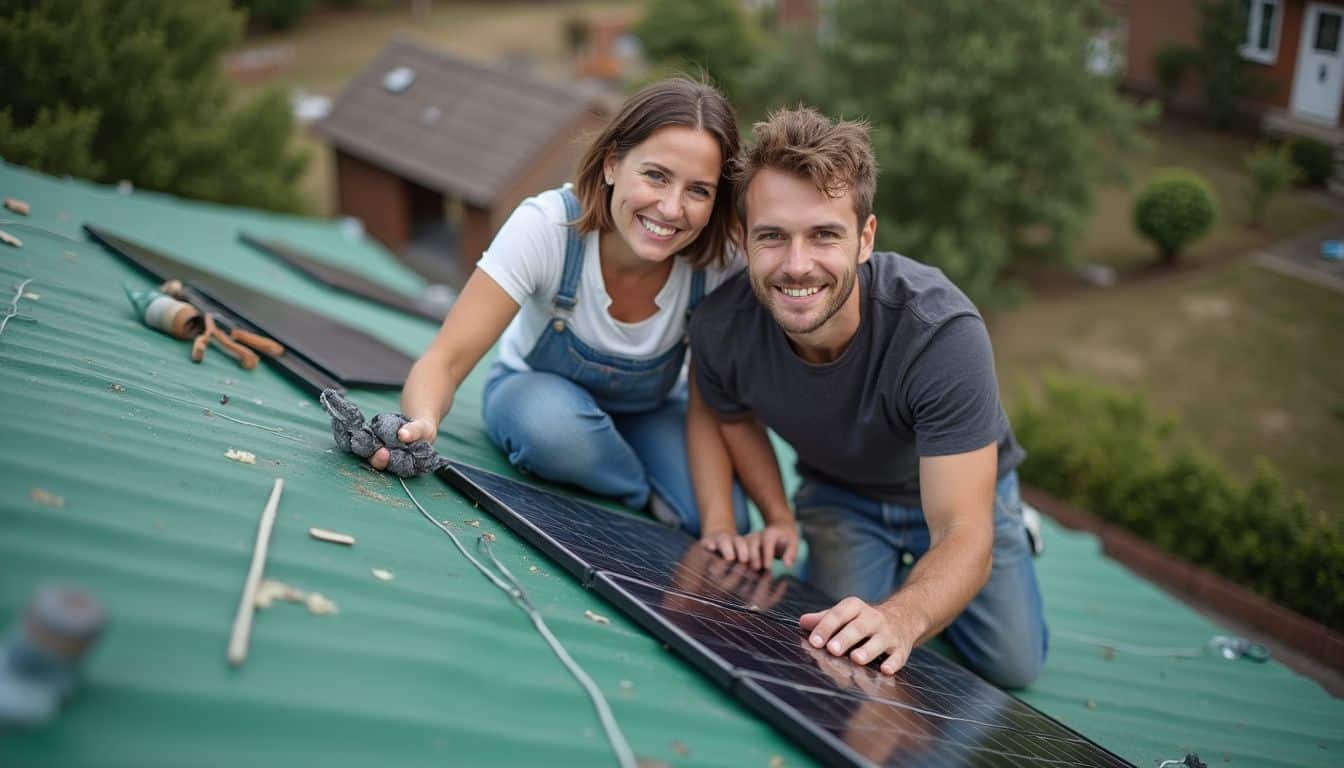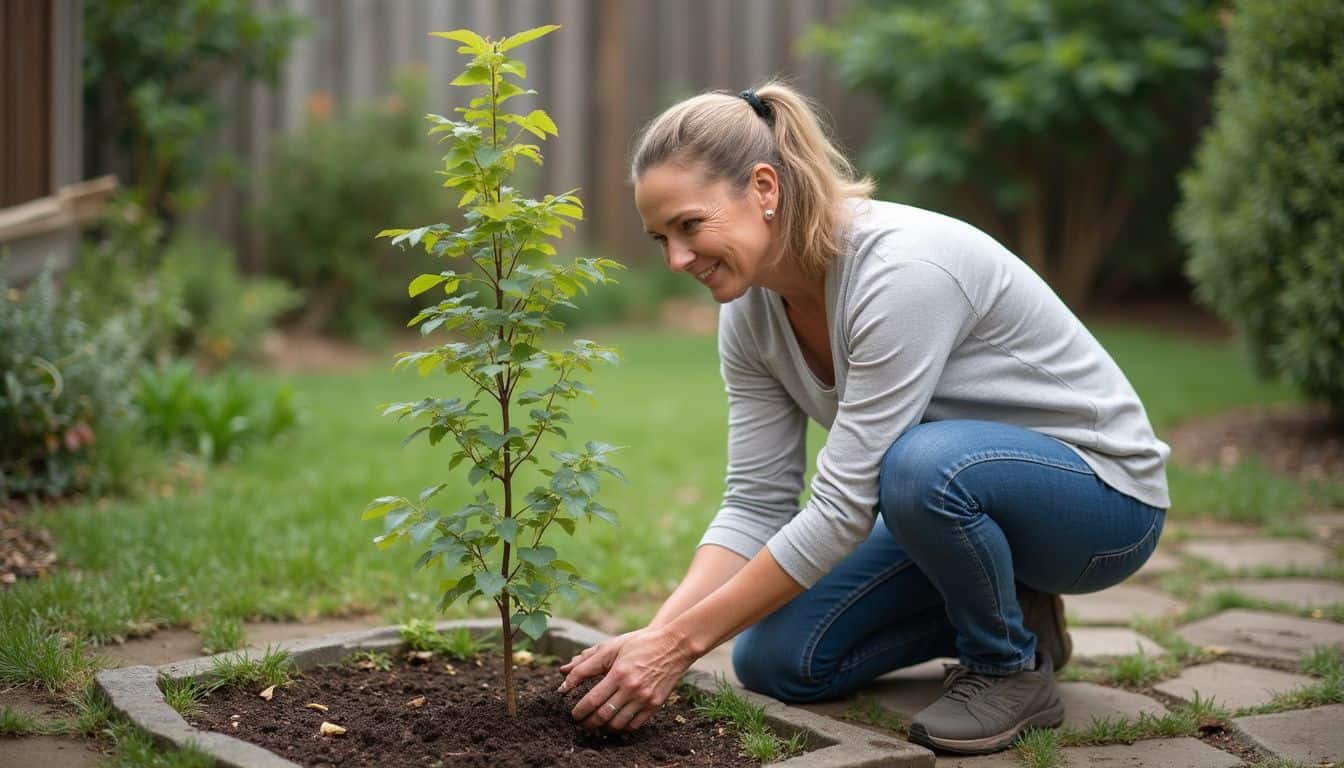Ever find yourself feeling a little too sweaty indoors, even with the AC on? Or maybe you’re getting more worried each time a big storm batters your windows?
You’re not imagining it. Climate change is bringing more extreme weather and rising heat.
With 85% of Australians living near the coastline, our homes are feeling the pressure.
I’m going to walk you through nine simple steps on how to make your home climate change ready. These tips will help boost your comfort, save you money, and protect your home from whatever the weather throws its way. Let’s get your space weatherproofed together.
Key Takeaways
Upgrading your home’s insulation and sealing air leaks can significantly cut energy costs. By adding insulation and using double-pane, low-e windows, you can reduce heating and cooling expenses by up to 20% and move closer to modern energy efficiency standards.
Protect your home from wildfire threats by installing fire-resistant roofing and siding. Materials like Class A asphalt shingles or fiber cement siding are excellent choices that align with FEMA’s guidelines for creating defensible space.
You can lower the risk of water damage from floods or storms by making a few key adjustments. Elevating electrical outlets 12 inches above potential flood levels, installing flood-resistant flooring, and keeping your gutters clean are critical steps.
Harnessing solar energy can lower your electric bills and shrink your carbon footprint. Thanks to the Residential Clean Energy Credit, you may be able to cover up to 30% of the cost of installing solar panels.
Regular home maintenance makes a huge difference. Performing a home energy audit, changing HVAC air filters, and installing smart thermostats like the Google Nest can save you up to 10% on energy bills and prepare your home for harsher weather.
Table of Contents
How to Improve Your Home’s Energy Efficiency

Slashing your energy bills can start with a few simple fixes, like sealing up cracks and adding more insulation in the attic. When you make these changes, your heating and cooling systems don’t have to work so hard, even on the most extreme days.
How can I add insulation to walls and attics?
Adding insulation is one of the smartest upgrades you can make for both comfort and energy savings. My first home was so drafty until I spent a weekend insulating the attic, and the difference was incredible.
A great starting point is a professional home energy assessment. Many utility companies offer these, sometimes for free, to pinpoint exactly where you’re losing energy.
When it comes to materials, you have a few good options:
- Fiberglass batts: Brands like Owens Corning are popular for DIY projects because they are pre-cut to fit between standard joists and studs.
- Cellulose: This is often made from recycled paper and is great for blowing into existing walls or adding on top of old attic insulation.
- Spray foam: This is a job for pros, but it creates an excellent air seal in tight spaces.
A well-insulated home can save you up to 15% on your heating and cooling costs, according to the U.S. Environmental Protection Agency. Plus, the Inflation Reduction Act of 2022 offers the Energy Efficient Home Improvement Credit, which can cover 30% of insulation costs, up to $1,200 a year. This makes a big project much more affordable.
What is the best way to seal gaps and install weather stripping?
Those tiny gaps around your doors and windows might not seem like a big deal, but they can be major sources of energy loss. Sealing them is a quick win for improving your home’s energy efficiency.
- Do a quick inspection. On a sunny day, close your doors and blinds and look for any slivers of light around window frames and door jambs. You can also use a lit incense stick; if the smoke wavers, you have a draft.
- Choose the right materials. For a durable, long-lasting seal, go with silicone or rubber weather stripping. It holds up much better against sweltering heat and winter cold than cheaper foam tapes.
- Clean the surface first. Before you apply any new weather stripping, make sure to clean the area with rubbing alcohol to remove any dust or old adhesive. This helps the new strip stick properly.
- Don’t forget the hidden spots. Check for gaps around dryer vents, outdoor faucets, and where pipes enter your home. A can of insulating foam sealant, like Great Stuff, works wonders for these areas.
Sealing these air leaks is a simple weekend project that can pay for itself in just one year. It keeps your home more comfortable and helps you prepare for the bigger steps in climate-proofing your space.
Why replace single-pane windows with double-pane, low-emissivity windows?
If you have old, single-pane windows, upgrading them is like giving your house a warm coat for winter and a pair of sunglasses for summer. Modern double-pane windows with a low-emissivity (low-e) coating can make a huge difference.
The low-e coating is a microscopic metallic layer that reflects heat. In the summer, it reflects the sun’s heat out, and in the winter, it keeps your home’s warmth in. ENERGY STAR certified windows can lower your energy bills by an average of 12 percent nationwide.
Top brands like Andersen and Pella offer a range of styles with excellent energy ratings, and you can even find high-quality German windows in USA for those seeking imported efficiency. While it’s a bigger investment, new windows not only improve comfort but also reduce outside noise and can increase your home’s value.
“Swapping single-pane for double-pane low-e windows is like trading flip-flops for rain boots before storm season—way more practical.”
How does installing a smart thermostat save energy?
A smart thermostat is a fantastic tool for cutting energy waste without even thinking about it. I set mine to lower the heat after we leave for the day and then warm the house up again just before we get home.
Models like the Google Nest Learning Thermostat actually learn your habits and create a schedule for you. The Ecobee Smart Thermostat comes with room sensors to make sure the rooms you’re actually in are comfortable, not the empty ones.
Most smart thermostats can be controlled from an app on your phone, so you can adjust the temperature from anywhere. The EPA’s ENERGY STAR program reports that homes with smart thermostats can save an average of 8% on heating and cooling costs, which adds up month after month. For more ways to stay cool, check out the benefits of ceiling fans.
How to Enhance Your Home’s Resilience to Extreme Weather

With storms getting stronger, it’s smart to give your home a little extra armor. Things like fire-resistant siding, storm shutters, and clean gutters can help your house stand strong when extreme weather hits.
What are fire-resistant roofing and siding materials?
If you live in an area prone to wildfires, the materials on the outside of your home are your first line of defense. Choosing fire-resistant materials can make a critical difference.
- Roofing: Look for materials with a Class A fire rating, which is the highest level of protection. Good options include fiberglass-asphalt shingles (like those from GAF), metal roofing, and classic clay or concrete tiles.
- Siding: Fiber cement siding, made by companies like James Hardie, is a top choice because it doesn’t ignite when exposed to direct flame and is resistant to heat. Stucco and brick are also excellent non-combustible choices.
Beyond materials, the Federal Emergency Management Agency (FEMA) stresses the importance of creating defensible space. This means clearing a buffer zone around your house. The first five feet should be free of all flammable materials, which means using things like gravel or pavers instead of wood mulch right up against your foundation. For more ideas, you can check out this guide for cost-effective roofing materials.
How can I elevate electrical outlets and use flood-resistant flooring?
When it comes to flood risk, moving critical systems up and away from potential water is key. Even a few inches of water can cause major damage, so a little planning goes a long way.
The National Construction Code and FEMA both recommend having a licensed electrician raise electrical outlets, switches, and circuit breakers at least 12 inches above the projected flood elevation for your area.
You should also think about your flooring on the ground level. If you live in a flood-prone area, it’s best to avoid wall-to-wall carpeting. Instead, opt for flood-resistant materials that can handle getting wet:
| Flooring Type | Why It Works |
|---|---|
| Porcelain or Ceramic Tile | Completely waterproof and easy to clean after a flood. |
| Luxury Vinyl Tile (LVT) | A waterproof option that mimics the look of wood or stone. |
| Sealed or Polished Concrete | Durable, waterproof, and requires minimal cleanup. |
Why should I clean gutters and store valuables off the ground?
It’s one of those chores that’s easy to put off, but keeping your gutters clean is so important. When gutters get clogged with leaves and debris, rainwater has nowhere to go but over the sides, where it can soak into your walls and foundation.
This overflow can lead to serious water damage and even cause mold to grow inside your home. In the winter, clogged gutters can form ice dams, which can force water under your shingles and lead to a leaky roof.
I learned this lesson the hard way one year when a sudden downpour sent water cascading over my porch and into the basement. Now, I make sure to clean them out every fall and spring.
It’s also a smart idea to store sentimental items, like family photos and important documents, in waterproof bins on high shelves in your basement or garage. This simple step can save you from heartbreak if water does find its way in.
How to Generate Clean Energy at Home

Generating your own clean energy is a powerful way to reduce your carbon footprint and your reliance on the grid. With options like solar panels and green roofs, your home can become part of the climate solution.
What should I know about installing solar panels?
Installing solar panels has become much more accessible for homeowners in recent years. The technology has improved, prices have come down, and there are great financial incentives available.
One of the biggest helps is the federal Residential Clean Energy Credit. This tax credit allows you to deduct 30% of the cost of installing a solar energy system from your federal taxes. This credit runs through 2032, making it a great time to consider solar power.
Here are a few tips to get started:
- Get multiple quotes. Reach out to at least three different installers to compare costs and equipment options. Look for professionals who are certified by the North American Board of Certified Energy Practitioners (NABCEP).
- Check your roof’s condition. Before installation, have a professional inspect your roof to make sure it’s in good shape and can support the weight of the panels.
- Understand net metering. Many utility companies have net metering programs that allow you to sell any excess electricity your panels generate back to the grid, which can further lower your monthly bills. Be sure to check the available federal tax credits in your area.
How does a green roof improve insulation?
A green roof is essentially a living garden on top of your house. It’s made up of layers of soil, a waterproof membrane, and hardy plants like sedums.
This layer of vegetation acts as a natural insulator. In the summer, it absorbs heat and helps keep your home cooler, which can reduce your need for air-conditioning. According to the EPA, green roofs can reduce a building’s cooling load by shading the roof surface and through evaporative cooling from the plants.
In the winter, that same layer helps to prevent heat from escaping. Green roofs also do a fantastic job of absorbing stormwater runoff, which can ease the burden on local sewer systems during heavy rains.
How to Create a Climate-Friendly Landscape

Your yard can be a powerful tool in making your home more climate-ready. By planting shade trees, using surfaces that absorb water, and collecting rainwater, you can create a landscape that is both beautiful and resilient.
How can planting trees provide shade and cooling?
Planting deciduous trees, like maples or oaks, on the east, west, and northwest sides of your house can provide wonderful shade during the hot summer months. According to the U.S. Department of Agriculture, this natural shade can reduce a household’s energy use for air conditioning by up to 25%.
I planted two red maples a few years ago, and now my kids can play in the backyard on summer afternoons without overheating. The leafy canopy also helps cool the whole neighborhood, combating the urban heat island effect.
In the winter, after the leaves have fallen, the bare branches allow sunlight to pass through and help warm your home. It’s a perfect example of passive cooling and heating that works with nature.
What are permeable surfaces and how do they reduce water runoff?
Instead of a traditional asphalt or concrete driveway, consider using permeable surfaces. These are materials that allow rainwater to soak through into the ground instead of running off into storm drains.
I swapped out an old concrete patio for permeable pavers, and it completely solved the problem of puddles in my backyard after a storm. Good options include:
- Pervious concrete or asphalt
- Interlocking pavers with gaps filled with gravel
- Plastic grid pavers filled with grass or gravel
By letting water filter through, these surfaces help to reduce flood risks and recharge groundwater. The EPA notes that they also do a great job of filtering out pollutants from stormwater, which helps keep our local waterways clean.
How do rain barrels help with water conservation?
A rain barrel is a simple and effective way to capture the rainwater that runs off your roof. I have a 50-gallon barrel connected to one of my downspouts, and it fills up surprisingly fast after a good rain.
Just one inch of rain falling on a 1,000-square-foot roof can provide over 600 gallons of water. You can use this collected water for your garden, houseplants, or even for washing your car.
It’s a great way to conserve water, especially during summer droughts, and it can help lower your utility bills. Just be sure to keep your barrel covered with a screen to prevent mosquitoes from breeding.
How Can I Prepare My Home for Heatwaves?
When a serious heat wave hits, it can put a major strain on your home and your health. Having a plan to stay cool can make all the difference.
Where should I designate a cool, shaded area in my home?
During a heatwave, it’s smart to designate one room in your house as a “cool room.” This should ideally be a room on the north side of your house or in your basement, as these areas tend to stay naturally cooler.
Keep the blinds and curtains closed in this room during the day to block out the sun. Blackout curtains are especially effective at this. You can also use fans to create a cross-breeze for some natural ventilation.
By focusing your cooling efforts on one area, you can stay comfortable without having to run your air conditioning at full blast all day long.
How does reflective window film or shades reduce heat?
Even with the blinds closed, a lot of heat can still get in through your windows. Reflective window film is a great solution for this. It’s a thin film that you apply directly to the glass, and it works by reflecting solar radiation back outside.
I installed some Gila window film on my west-facing windows, and the difference was immediate. The room felt several degrees cooler, and the glare on the TV was gone. Some films can block up to 78% of the sun’s heat, which can lead to significant savings on your cooling costs.
It’s a simple DIY project that provides a big return in comfort during those scorching summer months.
How Can I Adapt My Home to Changing Water Levels?
With climate change, we’re seeing more intense rainfall and rising sea levels, which can increase the risk of flooding. Taking steps to adapt your home to changing water levels can provide valuable peace of mind.
Why should appliances and critical systems be elevated?
If you live in an area with any flood risk, it’s a good idea to elevate your major appliances and utility systems. This includes your washer, dryer, water heater, and HVAC units.
You can place them on sturdy concrete blocks or a raised platform to lift them above potential floodwaters. According to FEMA, elevating your utilities can be one of the most effective ways to prevent costly damage during a flood.
Protecting these systems not only saves you money on repairs but also ensures you can get your home back to normal more quickly after a storm.
When and how should I install sump pumps in flood-prone areas?
A sump pump is your best defense against a wet basement or crawl space. It’s a small pump that is installed in the lowest part of your basement, and it automatically turns on to pump out any water that collects there.
- Choose the right pump. It’s worth investing in a high-quality submersible pump from a trusted brand like Zoeller or Wayne.
- Get a battery backup. This is critical. Storms that cause flooding often knock out the power, so a battery backup ensures your sump pump will keep working when you need it most.
- Test it regularly. At least once a year, pour a bucket of water into the sump pit to make sure the pump kicks on and drains the water away.
- Install a water alarm. For extra peace of mind, place a smart water detector near your sump pump. It will send an alert to your phone if it detects any water.
I’ll never forget my neighbor scrambling during a midnight storm because her old pump failed. After that, she swore by professional installation and regular tests. A reliable sump pump can be the difference between a dry basement and a disaster.
What Are Proactive Maintenance Tips for a Climate-Ready Home?
Staying on top of regular maintenance is one of the best ways to keep your home running efficiently and spot potential problems before they become big ones. A home energy audit and regular HVAC check-ups are great places to start.
How do I perform an energy audit to find weak points?
An energy audit is a check-up for your home’s energy use. You can do a simple DIY audit yourself or hire a professional for a more detailed analysis.
To do your own audit, start by walking through your home and looking for obvious air leaks. Check the caulking around windows and the weather stripping on doors. You can also get a thermal leak detector for under $50, which helps you find hidden drafts in your walls and ceilings.
You should also check the insulation in your attic. If it’s below the level of the floor joists, you probably need to add more. The U.S. Department of Energy has free guides on its website to walk you through a more thorough DIY audit.
Why is it important to clean air filters and maintain HVAC systems regularly?
A dirty air filter makes your HVAC system work harder to pull in air, which wastes energy and drives up your bills. I was shocked when my electric bill shot up one summer, only to find that I had forgotten to change the filter for a few months.
You should replace your furnace and air conditioning filters every 1-3 months. It’s also a good idea to have your HVAC system professionally serviced once a year. A technician will clean the coils and check for any issues, which keeps the system running at peak efficiency and can extend its lifespan.
This simple maintenance helps your home handle the demands of a changing climate and keeps the air you breathe cleaner.
How Will Climate-Ready Home Strategies Evolve in 2025?
As we look ahead, making our homes climate-ready will become even more integrated into our daily lives. Expect to see more smart home technology and digital tools designed to help you manage your home’s resilience.
Building professionals are already incorporating climate-resilient design into new homes, from creating firebreaks in landscaping to using materials that can withstand high winds and heat.
A 2019 report from the National Institute of Building Sciences found that for every $1 spent on federal mitigation grants, society saves $6 in future disaster costs. It’s clear that taking proactive steps is a smart investment.
Insurance costs are rising as severe weather events become more common. By making these upgrades, from installing smart thermostats to adding solar panels, you’re not just preparing for the future; you’re building a safer, more reliable, and more affordable home for your family.
People Also Ask
What are the first steps to make my house climate change ready?
Your first step is to check for and seal any air leaks around windows and doors, which keeps your home efficient during heat waves and safe from storms.
How can I protect my home from flooding?
Install a sump pump with a battery backup to protect your basement from flooding, even if the power goes out during a storm. Since FEMA data shows floods are the most common natural disaster, you should also keep your gutters clean to direct rainwater away from your foundation.
Do energy upgrades really help with climate change?
Yes, upgrading to appliances with the ENERGY STAR label can save the average family hundreds on utility bills each year. Plus, the Inflation Reduction Act offers federal tax credits that can cover up to 30% of certain energy-efficient home improvements.
Is it expensive to get my home ready for extreme weather?
Some changes are very affordable, like adding weatherstripping to doors for under $30, while bigger projects like solar panels are an investment. However, federal programs like the Residential Clean Energy Credit can reduce the cost of a solar installation by 30%, making it more accessible.
References
https://www.callrevise.com/guide-to-home-insulation/
https://genzryan.com/blog/how-to-install-smart-thermostat/ (2024-10-15)
https://www.acromanservice.com/smart-thermostats-maximizing-comfort-and-efficiency
https://www.thisoldhouse.com/roofing/21018219/fire-resistant-roofing-and-siding (2024-08-30)
https://journal.uitm.edu.my/ojs/index.php/BEJ/article/download/6495/3975
https://earth911.com/home-garden/solar-power-9-crucial-steps/
https://www.sciencedirect.com/science/article/pii/S2405844023031249
https://www.arborday.org/tree-resources/summer-shade
https://www.epa.gov/soakuptherain/soak-rain-permeable-pavement
https://takechargeva.com/resource/blog/2025/7/9/designing-your-homes-for-extreme-heat
https://www.aptinting.com/window-film-for-heat/
https://www.clasp.ngo/report/net-zero-heroes/appliances-impacts-and-benefits/
https://www.penfed.org/mortgage/article/how-to-prepare-your-home-for-climate-change
https://forever-guard.multiscreensite.com/blog/sump-pump-installation-a-guide-for-flood-prone-areas
https://happyplumbing.com/blog/how-sump-pumps-protect-your-home-from-flooding/
https://www.energy.gov/energysaver/home-energy-assessments
https://home.howstuffworks.com/green-living/home-energy-audit.htm
https://www.energy.gov/energysaver/air-conditioner-maintenance
https://ductarmor.com/the-importance-of-regularly-changing-and-cleaning-air-filters/
https://fourquarters.co.in/2025/08/28/how-to-make-your-home-climate-resilient-future-proof-your-property/ (2025-08-28)
